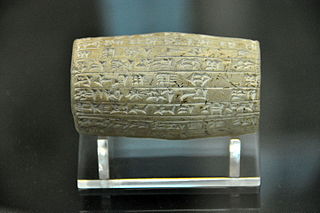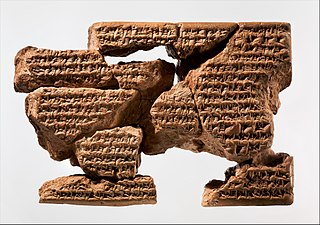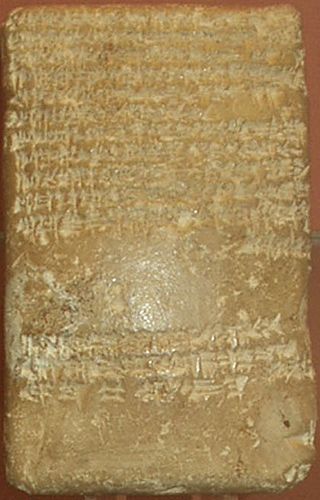Related Research Articles

Babylonia was an ancient Akkadian-speaking state and cultural area based in the city of Babylon in central-southern Mesopotamia. It emerged as an Amorite-ruled state c. 1894 BC. During the reign of Hammurabi and afterwards, Babylonia was called "the country of Akkad", a deliberate archaism in reference to the previous glory of the Akkadian Empire. It was often involved in rivalry with the older state of Assyria to the north and Elam to the east in Ancient Iran. Babylonia briefly became the major power in the region after Hammurabi created a short-lived empire, succeeding the earlier Akkadian Empire, Third Dynasty of Ur, and Old Assyrian Empire. The Babylonian Empire rapidly fell apart after the death of Hammurabi and reverted to a small kingdom.

Nabopolassar was the founder and first king of the Neo-Babylonian Empire, ruling from his coronation as king of Babylon in 626 BC to his death in 605 BC. Though initially only aimed at restoring and securing the independence of Babylonia, Nabopolassar's uprising against the Neo-Assyrian Empire, which had ruled Babylonia for more than a century, eventually led to the complete destruction of the Assyrian Empire and the rise of the Neo-Babylonian Empire in its place.

Sîn-šar-iškun was the penultimate king of Assyria, reigning from the death of his brother and predecessor Aššur-etil-ilāni in 627 BC to his own death at the Fall of Nineveh in 612 BC.

Ashur-uballit I(Aššur-uballiṭ I), who reigned between c. 1363 and c. 1328 BC, was the first king of the Middle Assyrian Empire. After his father Eriba-Adad I had broken Mitanni influence over Assyria, Ashur-uballit I's defeat of the Mitanni king Shuttarna III marks Assyria's ascendancy over the Hurri-Mitanni Empire, and the beginning of its emergence as a powerful empire. Later on, due to disorder in Babylonia following the death of the Kassite king Burnaburiash II, Ashur-uballit established Kurigalzu II on the Babylonian throne, in the first of what would become a series of Assyrian interventions in Babylonian affairs.
Enlil-kudurrī-uṣur, mdEnlil(be)-ku-dúr-uṣur,, was the 81st king of Assyria according to the Assyrian King List.

Burna-Buriaš II, rendered in cuneiform as Bur-na- or Bur-ra-Bu-ri-ia-aš in royal inscriptions and letters, and meaning servant or protégé of the Lord of the lands in the Kassite language, where Buriaš is a Kassite storm god possibly corresponding to the Greek Boreas, was a king in the Kassite dynasty of Babylon, in a kingdom contemporarily called Karduniaš, ruling ca. 1359–1333 BC, where the Short and Middle chronologies have converged. Recorded as the 19th King to ascend the Kassite throne, he succeeded Kadašman-Enlil I, who was likely his father, and ruled for 27 years. He was a contemporary of the Egyptian Pharaohs Amenhotep III and Akhenaten. The proverb "the time of checking the books is the shepherds' ordeal" was attributed to him in a letter to the later king Esarhaddon from his agent Mar-Issar.
Enlil-nirari was King of Assyria from c. 1327 BC to 1318 BC during the Middle Assyrian Empire. He was the son of Aššur-uballiṭ I. He was apparently the earliest king to have been identified as having held eponym, or limmu, office.

Karduniaš, also transcribed Kurduniash, Karduniash, Karaduniše, ) is a Kassite term used for the kingdom centered on Babylonia and founded by the Kassite dynasty. It is used in the 1350-1335 BC Amarna letters correspondence, and is also used frequently in Middle Assyrian and Neo-Assyrian texts to refer to the kingdom of Babylon. The name Karaduniyaš is mainly used in the letters written between Kadashman-Enlil I or Burna-Buriash, Kings of Babylon, and the Pharaoh of Ancient Egypt -, letters EA 1-EA 11, a subcorpus of letters,.

The Middle Assyrian Empire was the third stage of Assyrian history, covering the history of Assyria from the accession of Ashur-uballit I c. 1363 BC and the rise of Assyria as a territorial kingdom to the death of Ashur-dan II in 912 BC. The Middle Assyrian Empire was Assyria's first period of ascendancy as an empire. Though the empire experienced successive periods of expansion and decline, it remained the dominant power of northern Mesopotamia throughout the period. In terms of Assyrian history, the Middle Assyrian period was marked by important social, political and religious developments, including the rising prominence of both the Assyrian king and the Assyrian national deity Ashur.
Burna-Buriyåš I, meaning servant of the Lord of the lands, was the first Kassite who really ruled over Babylonia, possibly the first to occupy the city of Babylon proper around 1500 BC, culminating a century of creeping encroachment by the Kassite tribes. He was the 10th king of this dynasty to be listed on the Assyrian Synchronistic Kinglist.
Kara-hardash (Kara-ḫardaš), also rendered Kadashman-Harbe and possibly Karaindash, was a king of Babylon. He became king of Babylon around 1333. He was the son of the Assyrian princess Muballitat-Sherua and the Babylonian king who preceded him. His rule was short, as shortly after his appointment as king, he was killed in an anti-Assyrian revolt. His death was avenged by his grandfather, the Assyrian king Ashur-uballit I. After suppressing the revolt and removing the usurper appointed by the Kassites, the Assyrians appointed Kurigalzu as king. The latter's connection to the Assyrians is unclear. It is not excluded that he was Kara-hardash's son.

Kurigalzu II was the 22nd king of the Kassite or 3rd dynasty that ruled over Babylon. In more than twelve inscriptions, Kurigalzu names Burna-Buriaš II as his father. Kurigalzu II was placed on the Kassite throne by the Assyrian king Aššur-Uballiṭ I, reigned during a period of weakness and instability for twenty five years, eventually turning on his former allies and quite possibly defeating them at the battle of Sugagu. He was once thought to have been the conqueror of the Elamites but this now tends to be assigned to the earlier king of this name, together with the Chronicle P account.

Chronicle P, known as Chronicle 22 in Grayson’s Assyrian and Babylonian Chronicles and Mesopotamian Chronicle 45: "Chronicle of the Kassite Kings" in Glassner's Mesopotamian Chronicles is named for T. G. Pinches, the first editor of the text. It is a chronicle of the second half of the second millennium BC or the Kassite period, written by a first millennium BC Babylonian scribe.
Aššur-uballiṭ II, also spelled Assur-uballit II and Ashuruballit II, was the final ruler of Assyria, ruling from his predecessor Sîn-šar-iškun's death at the Fall of Nineveh in 612 BC to his own defeat at Harran in 609 BC. He was possibly the son of Sîn-šar-iškun and likely the same person as a crown prince mentioned in inscriptions at the Assyrian capital of Nineveh in 626 and 623 BC.

The timeline of ancient Assyria can be broken down into three main eras: the Old Assyrian period, Middle Assyrian Empire, and Neo-Assyrian Empire. Modern scholars typically also recognize an Early period preceding the Old Assyrian period and a post-imperial period succeeding the Neo-Assyrian period.

The Sargonid dynasty was the final ruling dynasty of Assyria, ruling as kings of Assyria during the Neo-Assyrian Empire for just over a century from the ascent of Sargon II in 722 BC to the fall of Assyria in 609 BC. Although Assyria would ultimately fall during their rule, the Sargonid dynasty ruled the country during the apex of its power and Sargon II's three immediate successors Sennacherib, Esarhaddon and Ashurbanipal are generally regarded as three of the greatest Assyrian monarchs. Though the dynasty encompasses seven Assyrian kings, two vassal kings in Babylonia and numerous princes and princesses, the term Sargonids is sometimes used solely for Sennacherib, Esarhaddon and Ashurbanipal.
References
- 1 2 3 4 Podany, Amanda H. (2022). Weavers, Scribes, and Kings A New History of the Ancient Near East. Oxford University Press. p. 390. ISBN 9780190059040.
- ↑ Erskine, Andrew (2012). A Companion to Ancient History. Wiley. p. 184. ISBN 9781118451366.
- ↑ Grayson, Albert Kirk (1972). Assyrian Royal Inscriptions: From the beginning to Ashur-resha-ishi I. O. Harrassowitz. p. 50.
- 1 2 Legrain, Leon. "The Oldest Dated Royal Seal. The Seal of Basha-Enzu, B. C. 2900". www.penn.museum. Penn Museum.
- ↑ J. Oates – Babylon, 2003, pp 91–92
- ↑ Kuhrt, Amélie (2020). The Ancient Near East C.3000–330 BC (2 Volumes). Taylor & Francis. ISBN 9781136755552.
In spite of the tension between Babylonia and Assyria at this time, a rapprochement was reached between the two, sealed by the marriage of Karaindash, Burnaburiash II's son, and Muballitat-Sherua, the daughter of Ashur-uballit.
- ↑ Liverani, Mario (2013). The Ancient Near East History, Society and Economy. Taylor & Francis. ISBN 9781134750917.
Burnaburiash, unable to obtain an Egyptian princess, gladly accepted the Assyrian king's daughter, Muballitat-Sherua, as daughter-in-law
- ↑ Paul Collins (2008). From Egypt to Babylon: the international age 1550-500 BC. Trustees of the British Museum. p. 65.
- ↑ A. K. Grayson (1975). Assyrian and Babylonian chronicles. J. J. Augustin. p. 211.
- 1 2 3 The Selected Synchronistic Kings of Assyria and Babylonia in the Lacunae of A.117. Brill. 2020. pp. 207–208. ISBN 9789004430921.
- 1 2 3 Radau, Hugo (1908). Letters to Cassite Kings from the Temple Archives of Nippur. University of Pennsylvania Press. pp. 59–61. ISBN 9781512820805.